Manduca quinquemaculata quinquemaculata
|
|
Updated as per Fauna Entomologica De Nicarauga, November 2007
Updated as per SHILAP publication: Lista de Sphingidae del Uruguay, September, 2010; Msc Gabriela Bentancur Viglione; January 31, 2011
|
Manduca quinquemaculatus
Five-spotted hawkmoth
man-DOO-kuhmm kwin-kweh-magh-kewe-LAY-tus
(Haworth, 1803) Sphinx
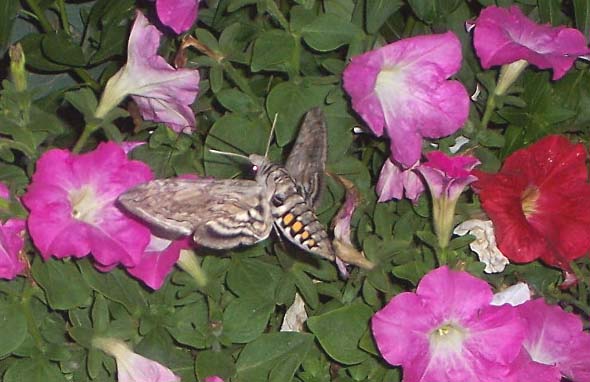
Manduca quinquemaculatus, Port Bruce, Ontario, Canada, July 9, 2005
courtesy of Jo Richardson and Jody Buchner.
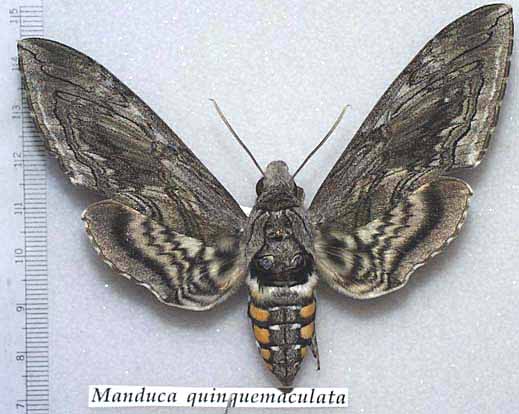
Manduca quinquemaculatus female courtesy of Bruce Walsh.
This site has been created by Bill Oehlke.
Comments, suggestions and/or additional information are welcomed by Bill.
TAXONOMY:
Family: Sphingidae, Latreille, 1802
Subfamily: Sphinginae, Latreille, [1802]
Tribe: Sphingini, Latreille, 1802
Genus: Manduca Hubner, 1807 ...........
Species: quinquemaculatus Haworth, 1803
|
DISTRIBUTION:
The Five-spotted hawkmoth,
Manduca quinquemaculatus
(Wing span: 3 9/16 - 5 5/16 inches (9 - 13.5 cm))
flies in tobacco fields, vegetable gardens, and wherever host plants
are found within its range, generally from
Nicaragua: Managua;
Mexico
north throughout
most of the United States and occasionally southern Canada, but it is
uncommon in the Southeast and the Great Plains. There are reports
from Hawaii and Brazil and Uruguay.
I have never seen one on Prince Edward Island, Canada, but
frequently saw them nectaring at railroad-side phlox at dusk or at
lights in New Jersey.
The moth abdomen usually has five but sometimes six pairs of yellow
bands. The upperside of the forewing is blurry
brown and gray. The upperside of the hindwing is banded with brown
and white and has two well-separated median
zigzag bands. The forewing fringes are grayish, not distinctly
spotted with white.
The specimen type locality is England. |
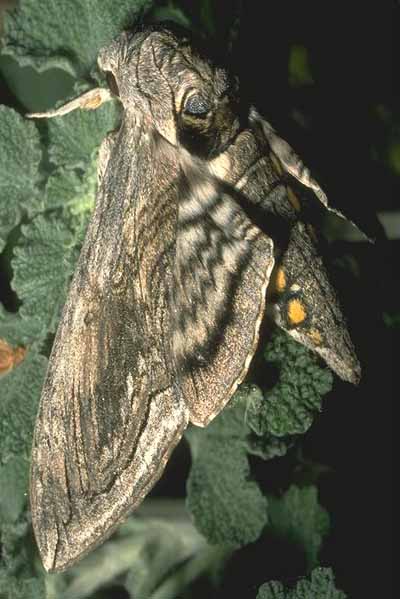 |
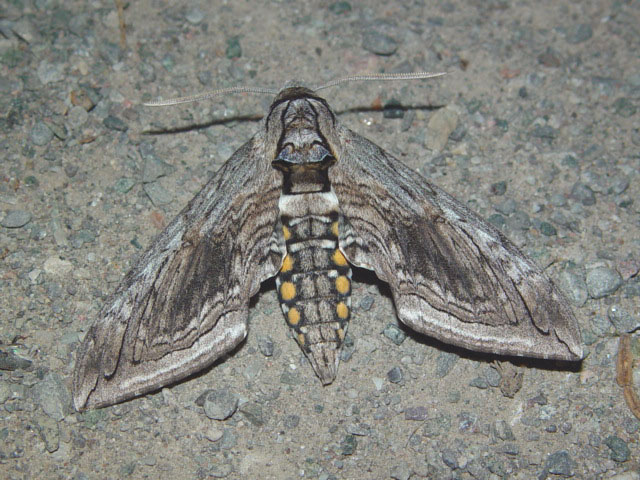
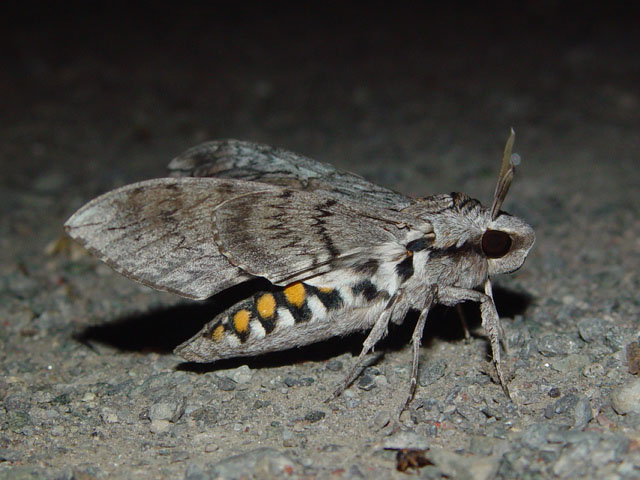
Manduca quinquemaculatus, Peterborough, Ontario, June 30 - July 1, courtesy
of Tim Dyson.
FLIGHT TIMES:
Manduca quinquemaculatus
adults fly as several broods from February-October in Florida and
from April-October in Louisiana. There are at least two broods from
May-October in the rest of the range.
Visit Manduca quinquemaculatus, Shreveport, Caddo Parish, Louisiana, June 30, 2013, Jeff Trahan.
Visit Manduca quinquemaculatus, Tempe, Maricopa County, Arizona, June 30, 2016, Nadia Smith
Visit Manduca quinquemaculatus, Smith Valley, La Crosse County, Wisconsin,
September 3, 2007, courtesy of Mary Ann Roesler.
Visit Manduca quinquemaculatus, nectaring at petunia, Noelridge Park, Cedar Rapids,
Linn County, Iowa, September 4, 2011, Tom Jantscher.
ECLOSION:
Pupae probably wiggle to surface from
subterranean chambers just prior to eclosion.
SCENTING AND MATING:
Females call in the
males with a pheromone released from a gland at the tip of
the abdomen. The adults nectar from flowers including Japanese
honeysuckle (Lonicera japonica), petunia
(Petunia hybrida), bouncing bet (Saponaria officinalis),
tobacco (Nicotiana), and phlox (Phlox).
Here is the Five-Spotted Hawkmoth on a crinum flower.
Image courtesy of Norma J. Wood from North Central
Texas.
| 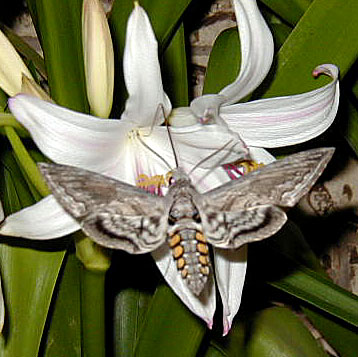 |
EGGS, LARVAE, PUPAE:
Adults fly at dusk, and females
deposit eggs singly on the upper surface of host plant leaves. The
caterpillars are called Tomato Hornworms and each has a black horn at the end of the abdomen.
Caterpillars have huge appetites for leaves and fruits and can
defoliate plants quickly. Fully-grown caterpillars pupate
and overwinter in soil burrows.
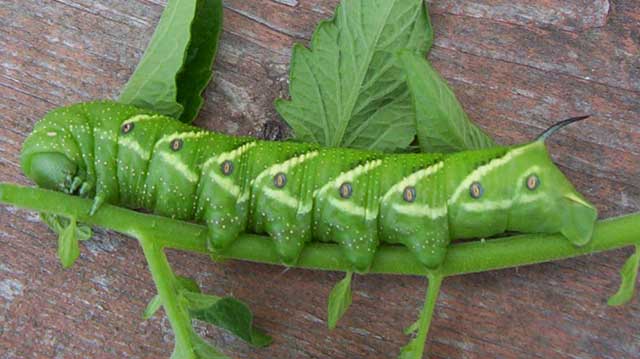
Manduca quinquemaculatus, just north of Emily
Conservation Park,
between Lindsay and Peterborough, Ontario, Canada,
August 6, 2006, courtesy of Keith Mcconachie.
Larvae feed on potato, tobacco, tomato, and other plants in the
nightshade family (Solanaceae).
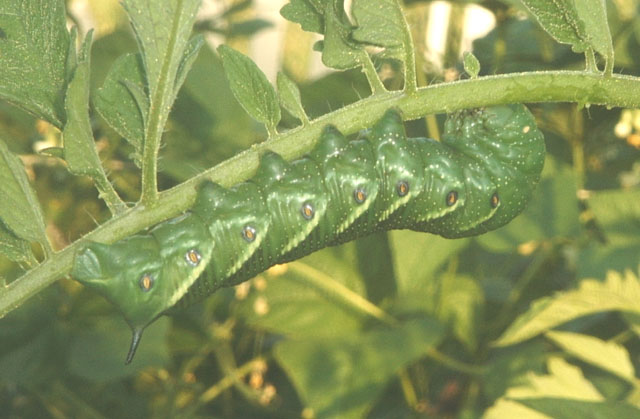
Manduca quinquemaculatus on tomato, courtesy of
Jonathan Tubbs, (Otsego County, Michigan)
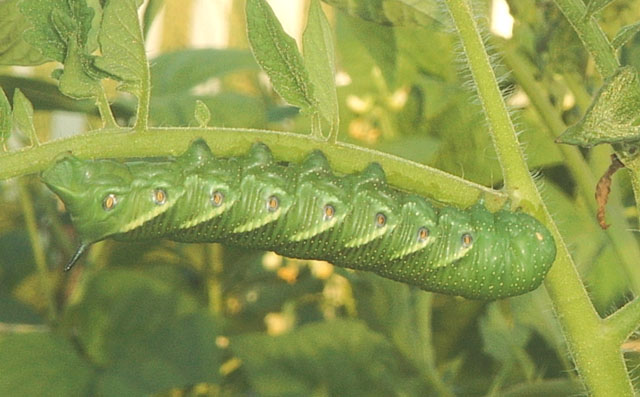
Manduca quinquemaculatus on tomato, courtesy of
Jonathan Tubbs, (Otsego County, Michigan)
Larvae also exhibit a dark form and in some specimens,
both green and dark forms, there is a cream coloured
supspiracular line and an extra half slash on the last
abdominal segment as per David Bygott's image from Arizona.
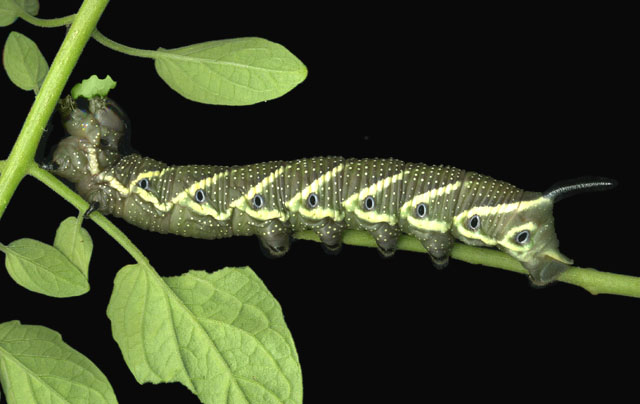
Manduca quiquemaculatus fifth instar, dark form,
Tucson, Arizona, August 17, 2006,
ravaging tomato plants,
courtesy of David Bygott, id confirmed
by James Tuttle.
Visit
Manduca quinquemaculatus
larval images (green and brown), courtesy of Mike Kuhl, Mount Hope, Ontario, Canada.
Visit
Manduca quinquemaculatus
larval images (green and brown), courtesy of Jill Burrows, Georgetown, Williamson County, Texas.
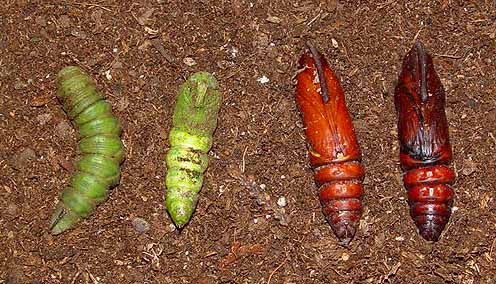
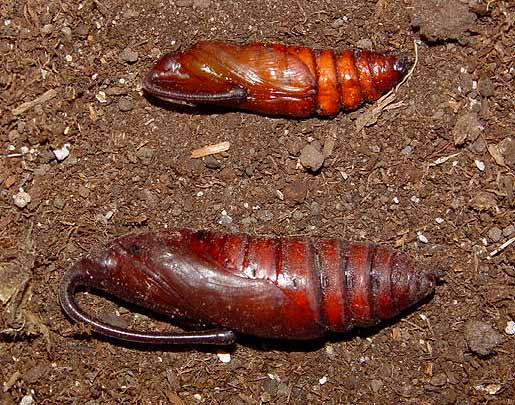
Images of pupae courtesy of Tim Dyson. Larvae will pupate without
soil in a tightly lidded plastic tub under loose paper towels. They
should not be handled until they have hardened (a few days after they
have darkened). The long curved projection from the head to the first
section of the abdomen houses the proboscis or feeding tube.
Caterpillars have many natural enemy. They are beset by many parasitoids and predators.
Eric Runfeldt sent me a short but graphic account of an attack by Polistes fuscatus,
a paper wasp, on one of the Manduca quinquemaculatus larvae in his garden.
Return to Sphingidae Index
Return to Sphingini Tribe
Use your browser "Back" button to return to the previous page.
This page is brought to you by Bill Oehlke and the
WLSS. Pages are on space rented from Bizland. If you would like
to become a "Patron of the Sphingidae Site", contact Bill.
Please send sightings/images to Bill. I will do my best to respond to
requests for identification help.
Enjoy one of nature's wonderments: Live
Saturniidae (Giant Silkmoth) cocoons.
 | 
Show appreciation for this site by clicking on flashing butterfly to the left.
The link will take you to a page with links to many insect sites. |













